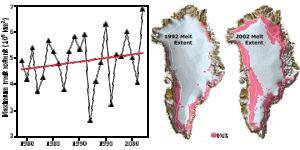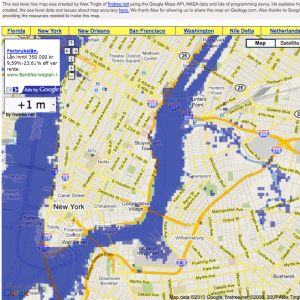Every school child learns that the Earth’s oceans cover roughly 3/4 of the planet’s surface, but what most of us don’t realize is that just 8 percent of that area covers the continental shelves — and that area provides 75 percent of all global fish catches — this I just learned from Callum Roberts’ excellent book, “The Unnatural History of the Sea,” which documents how we’ve been busily depleting fish stocks since our ancestors climbed down from the trees and figured out how to make hooks and toss them into the water. The whole book is an eye opener about how looking at past fisheries data tells us how much we have lost — and how we have to work even harder to protect what we have.
But the real reason I wanted to post this post was to observe, as Roberts does, that 87 percent of the area of the ocean is more than 1,000 meters deep — and for oceanographers interested in understanding how changing climate will change currents, this is where a lot -but not all — of the action is. And like the sleuthing that’s reported in Callum Roberts’ book, scientists are piecing together how the ocean’s currents will work in a warmer world by looking at the past.
Andreas Born, a German who has just defended his PhD at the University of Bergen in Norway, been looking at what has happened in the Eemian interglacial 126,000 years ago, before last ice age. It was warm then, and some scientists say this might be an example of the kind of warmer climate we can expect. But unlike now, the Earth overall was cooling, especially in the Arctic, as the ice age came on. Long story short, the northern extension of the Gulf Stream, the North Atlantic Current, shifted farther north and carried warmer subtropical waters to northern Europe. So while the Arctic overall was cooling (and those glaciers were starting to rumble out of northern Canada towards the US) the warm currents kept Scandinavia ice sheet free for several millennia.
A warmer Arctic
So what happens if the Arctic is actually warmer? Born predicts that as the sea ice cover shrinks, circulation in the subpolar region, called the subpolar gyre, will strengthen. That will essentially block the North Atlantic Current from bringing its warm waters up to Scandinavia.
Surface waters or deep waters?
What’s interesting about this prediction is that Born is essentially saying that surface currents will control the transport of warm Atlantic water into the Arctic — which is a little different than what a whole slew of researchers are looking at when they look at the Atlantic Meridional Overturning Circulation, which is a big conveyor belt of water that moves north on the surface of the Atlantic until it reaches the Arctic, then cools, plunges and heads south as deep water. One of Born’s colleagues at the Bjerknes Centre, Svein Østerhus, is looking at the movement of this deep water, as I described in a piece on ScientificAmerican.com. His pursuits include looking at the formation of the deepest coldest water in the world, in the Antarctic in the Weddell Sea. But more about that in a subsequent post.





